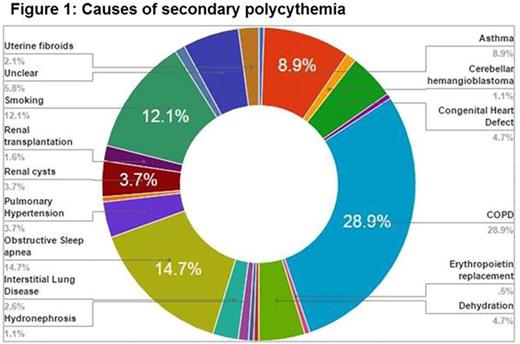Abstract

Background: Red cell overproduction in certain lung and heart conditions causing hypoxia is a well-known entity. This mechanism is thought to be compensatory to the chronic hypoxia. But how this red cell overproduction and other red cell variables affect the morbidity and mortality of these secondary or reactive erythrocytosis patients has not been studied. Our goal is to see the effect of red cell parameters and other routinely obtained laboratory values in the clinical outcomes of secondary erythrocytosis patients in our ethnically diverse and large urban population.
Methods: Patients ≥ 18 years of age seen at our center from 1998 to 2015 with a diagnosis of polycythemia or erythrocytosis, either primary or secondary, with follow up of at least one year, were included. This was done with the help of Clinical Looking Glass software after obtaining Institutional Review Board approval. Secondary erythrocytosis was confirmed by evaluating each medical record in detail. After confirming diagnosis, further evaluation and data collection were obtained including demographic variables, the following lab values at diagnosis and the mean values since diagnosis: Hemoglobin (Hb), Mean Corpuscular Volume( MCV), Red Cell Distribution Width ( RDW), White Blood Cell counts ( WBC), platelet counts and albumin level. All analyses were conducted using STATA statistical software. Kaplan-Meier curves were constructed to compare survival by various subgroups. Hazard ratios were calculated using multivariate Cox regression models to adjust for co-variates to compare mortality risk and identify potential independent predictors of mortality.
Results: 190 patients with secondary erythrocytosis and 69 patients with Primary Polycythemia Vera were included in the study. Our population with secondary erythrocytosis consisted of 48 % Hispanic, 27 % Caucasian and 25% African American subjects. The main causes of secondary erythrocytosis were Lung and cardiac diseases, namely Chronic Obstructive Pulmonary Disease (COPD) in 29% and Obstructive Sleep Apnea (OSA) in 15%. Figure 1 depicts the various causes of secondary erythrocytosis. We found significant higher survival in patients with secondary erythrocytosis compared to Primary Polycythemia Vera (p value: 0.05) as shown in Figure 2a. Amongst the various laboratory parameters, the strongest interaction with the disease status was of mean RDW with secondary erythrocytosis. Subjects with high mean RDW had significantly worse survival in the secondary erythrocytosis group with a p value of 1.02*10-6. Another intriguing finding was that higher hemoglobin levels, both at diagnosis and mean values, were not associated with worse survival in these patients. When we further evaluated secondary erythrocytosis patients with high RDW (> 16.1) to normal RDW, there was a very significantly worse survival in patients with high RDW (p-value = 7*10-5). Also, when we compared secondary erythrocytosis with high RDW and Primary Polycythemia patients, there was no difference in survival (Figures 2b and c).
Conclusions: This is a novel study in a minority rich population regarding the different common lab parameters in secondary erythrocytosis. RDW is a ubiquitously reported lab value. RDW is a measure of the range of variation of red blood cell volume that is reported as part of a standard complete blood count. Anisocytosis is when RBCs are of unequal sizes, thus equivalent to high RDW. Increased RDW has been linked to worse survival in various lung and heart diseases in the past. Our study proves this concept in the patients with reactive erythrocytosis often found in advanced lung and heart disease patients. Furthermore, our study gives a very strong possible explanation for this finding; that disordered overproduction of red blood cells under the stress of chronic hypoxia leads to higher RDW. The degree of hypoxia and resulting dyserythropoiesis might not be very obvious to the treating clinician and observing the trend of RDW could be very helpful in these situations. We conclude that high RDW in patients with secondary erythrocytosis should be taken very seriously and all attempts should be made to treat the underlying condition causing high hemoglobin.
No relevant conflicts of interest to declare.
Author notes
Asterisk with author names denotes non-ASH members.

This icon denotes a clinically relevant abstract



This feature is available to Subscribers Only
Sign In or Create an Account Close Modal